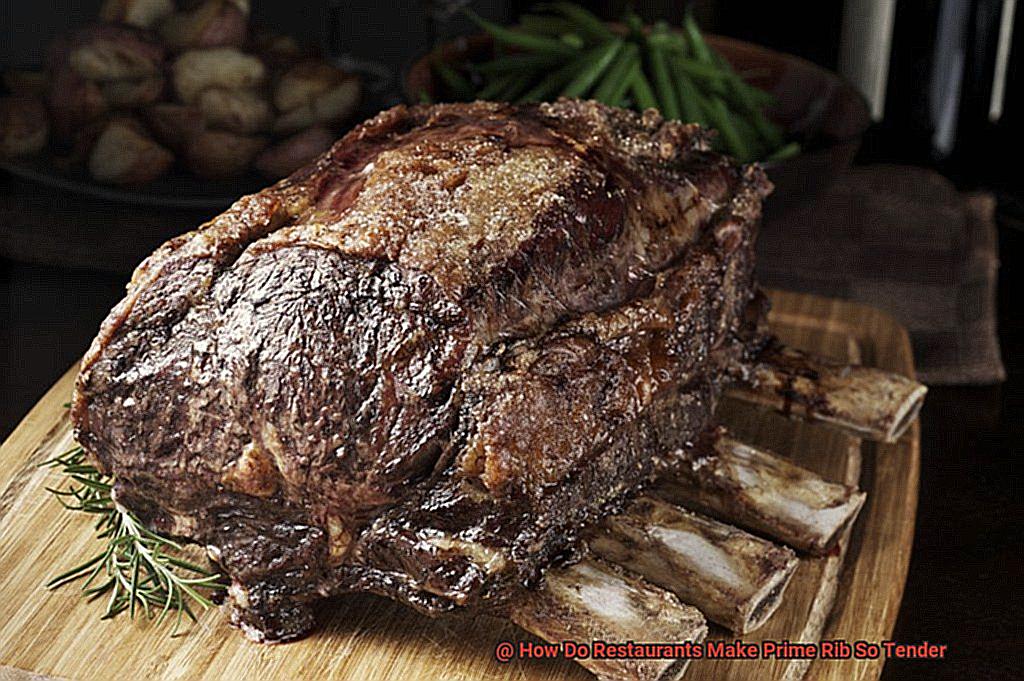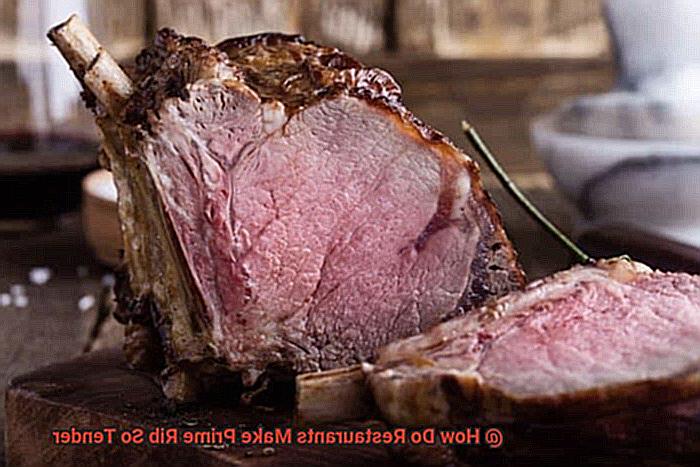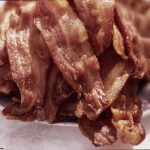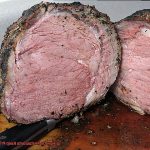Have you ever indulged in a succulent prime rib at a fancy restaurant and wondered how they made it so tender? Well, the secret lies in the cooking method and some simple yet effective techniques used by professional chefs.
For starters, the cut of meat is crucial. Restaurants typically opt for prime or choice grade beef, which is well-marbled with fat. The fat content helps to keep the meat juicy and infused with flavor, resulting in a melt-in-your-mouth experience.
Furthermore, restaurants age their prime rib. Dry-aging involves leaving the meat uncovered in a temperature-controlled environment for several days. This process allows natural enzymes to break down connective tissue, resulting in a more tender cut of meat that’s packed with flavor.

But it’s the cooking method that truly sets apart an exceptional prime rib from an average one. Many restaurants use a slow-roasting technique that allows the meat to cook evenly and retain its moisture while infusing it with rich flavors. The prime rib is typically cooked at low temperatures for several hours until it reaches the desired level of doneness.
Some chefs even employ a technique called sous-vide, where they seal the meat in vacuum-sealed bags and cook it in temperature-controlled water baths for an extended period. This ensures consistent and precise cooking, resulting in an incredibly tender prime rib that’s perfect every time.
So next time you savor a mouth-watering prime rib at your favorite restaurant, remember that it’s not just about quality meat but also about expert cooking techniques that make all the difference.
Contents
Cooking Technique: Dry-Heat Method
This method involves cooking the meat at high temperatures without any added liquid, allowing the heat to create a crust that seals in the flavors and juices.
To achieve a perfectly tender prime rib using the dry-heat method, restaurants often use a technique called “reverse searing.” The process involves cooking the meat at a low temperature for an extended period of time, then searing it at high heat for a short amount of time just before serving. This results in a juicy, mouth-watering dish that is sure to impress any guest.
Another important factor in making prime rib tender using the dry-heat method is allowing the meat to rest after cooking. During this time, the juices redistribute throughout the meat, making it more flavorful and tender. It’s crucial to rest the meat for at least 10-15 minutes before slicing into it to ensure maximum juiciness and flavor.
Restaurants often use specialized equipment like rotisseries or smokers to cook prime rib using the dry-heat method. These methods allow for even cooking and can add unique flavors to the meat. However, home cooks can still achieve delicious results using just their oven and a few basic tools.
Before cooking, be sure to season your prime rib generously with herbs, spices, and salt. Some popular seasoning options include rosemary, thyme, garlic, and black pepper. Preheat your oven to 325°F (163°C) for at least 20 minutes to ensure that it’s at the correct temperature before cooking.
Once your prime rib is cooked, allow it to rest for at least 10-15 minutes before slicing. Then serve with your favorite sides like roasted vegetables or mashed potatoes.
Seasoning: Herbs, Spices and Salt
When it comes to prime rib, restaurants rely on an artful combination of herbs, spices, and salt to unlock the full potential of this mouth-watering cut of meat.
Let’s start with herbs. Rosemary, thyme, and oregano are just a few examples of herbs used to season prime rib. These versatile flavor enhancers can be used fresh or dried and are typically rubbed onto the meat before cooking. The infusion of their aromatic oils tenderizes the meat and gives it a rich, savory taste that lingers on the palate.
Spices are equally important in prime rib seasoning. Paprika, cumin, and coriander are among the spices frequently used by chefs to add depth and complexity to the flavor profile of prime rib. Paprika, for instance, contains enzymes that break down tough proteins in the meat, resulting in a more tender cut that melts in your mouth.
Now let’s talk about salt. Salt is an indispensable part of prime rib seasoning. It not only enhances the flavor but also helps draw out moisture from the meat, resulting in a more succulent and juicy cut. Restaurants often prefer kosher salt as its larger grains better penetrate the meat compared to regular table salt.
Resting: Allow the Meat to Re-Distribute Juices
Resting your meat allows the juices to re-distribute, resulting in an even distribution of moisture and flavor in every bite.
When meat is cooked, the heat causes the juices to move towards the center of the cut, leaving some parts dry and others juicy. But by letting your meat rest for 20-30 minutes after cooking, the juices have time to redistribute throughout the cut, resulting in a more succulent final product.
Restaurants know this secret all too well. Their prime rib is typically covered with foil or a lid to keep it warm and prevent it from drying out during the resting period. This allows the juices to settle evenly throughout the meat, producing a tender and flavorful final product that will have you begging for more.
But how long should you let your meat rest? Well, that depends on the size of your cut. A smaller roast may only need 10-15 minutes of resting time, while a larger one may require up to an hour. It’s always a good idea to use a meat thermometer to check the internal temperature of the roast before carving, ensuring that it has reached your desired level of doneness.
Not only does resting allow the meat to re-distribute its juices, but it also makes it easier to carve without sacrificing tenderness. When meat is hot off the grill or out of the oven, it can be challenging to slice cleanly without losing some of its precious juices. Allowing it to rest gives the meat time to firm up slightly, making it easier to carve without sacrificing its succulence.
Benefits of Dry-Heat Cooking for Prime Rib
When it comes to making the perfect prime rib, dry-heat cooking is a go-to method for many restaurants and home cooks alike. And for good reason – this cooking technique has numerous benefits that result in an incredibly flavorful and tender dish.
One of the most significant advantages of dry-heat cooking is that it creates a crispy outer layer while keeping the inside moist and juicy. This is achieved by searing the meat at a high temperature for a short period, which locks in all the natural juices and flavors. The result is a succulent prime rib that’s bursting with flavor in every bite.
Another benefit of dry-heat cooking is its simplicity. Unlike other cooking methods that require complicated techniques or lengthy preparation, all you need for a delicious prime rib is your preferred spices and herbs, an oven or grill, and some patience as you let the meat cook to perfection. It’s a straightforward process that yields impressive results.
As if that wasn’t enough, dry-heat cooking is also incredibly versatile. Whether you’re using a bone-in or boneless cut of meat, this technique can be adapted to suit your needs. It’s an ideal choice for prime rib, as it allows for more control over the cooking process, ensuring that the meat is cooked to your desired level of doneness.
Popular Seasonings for Prime Rib
Look no further than the seasoning. The right combination of herbs, spices, and seasonings can elevate this classic dish from good to downright amazing. As an expert in all things prime rib, I’m here to share some of the most popular and delicious seasoning options with you.
Let’s start with the classics. A simple blend of salt and pepper is always a safe bet. This allows the natural flavors of the meat to shine through while still adding a touch of seasoning. If you’re looking for something a little more robust, try a dry rub made with fragrant herbs like rosemary, thyme, and garlic. This creates a savory and aromatic flavor that will have your taste buds singing.
If you’re feeling adventurous, there are plenty of other options to try. For those who like it spicy, a Cajun or blackened seasoning can add a nice kick to your dish. And for those who prefer sweet and savory flavors, a brown sugar and mustard glaze creates a caramelized crust on the prime rib while adding depth of flavor.
But why stop there? For a truly unique twist, experiment with different seasonings like garlic and herb butter or even a horseradish crust. And if you really want to mix things up, consider using a coffee rub for an unexpected burst of flavor.
No matter which seasoning you choose, remember that the key to achieving tender and flavorful prime rib is to start with high-quality meat and season it generously before cooking. With these popular seasoning options at your fingertips, you’ll be well on your way to creating restaurant-quality prime rib in the comfort of your own home.
In summary, here are some popular seasoning options for prime rib:
- Salt and pepper
- Dry rub with rosemary, thyme, and garlic
- Cajun or blackened seasoning for heat
- Brown sugar and mustard glaze for sweet and savory flavors
- Garlic and herb butter
- Horseradish crust
- Coffee rub for a unique twist
How to Apply Seasoning to Prime Rib
Seasoning is a crucial element in making a mouth-watering prime rib. Restaurants use a combination of herbs, spices, and salt to bring out the meat’s natural flavors and create an appetizing crust. Here are five easy steps on how to apply seasoning to prime rib:
Properly Prepare the Meat
Before seasoning, ensure that your prime rib is well prepared by trimming excess fat and tying it with butcher’s twine for even cooking.
Keep It Simple
Most restaurants use a blend of freshly ground black pepper and kosher salt to season their prime rib. This straightforward seasoning allows the meat’s natural flavor to shine through without overpowering it with other ingredients.
Rub It In
Once you have your seasoning blend ready, rub it all over the outside of the meat, ensuring that it is evenly coated on all sides. Some chefs may add other herbs or spices, such as garlic powder or rosemary, but be careful not to overdo it.
Marinate for Added Flavor
If you want to enhance the flavors further, try marinating your prime rib overnight in a mixture of wine, herbs, and spices. This will allow the flavors to penetrate deeply into the meat and result in a juicy and flavorful roast.
Let It Rest
After applying the seasoning, let your prime rib rest at room temperature for at least an hour before cooking. This helps the meat cook evenly and ensures perfect doneness with a delicious crust.
Tips for Perfectly Cooked and Tender Prime Rib
Well, the secret to their success lies in the cooking process. There are several tips and tricks that restaurants use to achieve perfectly cooked and tender prime rib. Let’s take a closer look at some of these techniques.
Choose the Best Quality Meat
One of the most important factors in achieving a tender prime rib is selecting a high-quality cut of meat. Restaurants often use USDA Prime grade beef, which has abundant marbling throughout the meat. This marbling helps to make the meat more tender and flavorful.
Proper Seasoning and Preparation
Proper seasoning and preparation are essential for achieving juicy and flavorful prime rib. Many restaurants use a dry rub made of herbs, spices, and salt to infuse flavor into the meat before cooking. They also let the meat come to room temperature for at least an hour before cooking to ensure even cooking.
Slow Roasting
Slow roasting is another key factor in achieving perfectly cooked and tender prime rib. This involves cooking the meat at a low temperature for an extended period. Slow roasting allows the meat to cook evenly and retain its moisture, resulting in juicy and tender prime rib.
Resting
After cooking, it’s important to let the meat rest before carving to ensure maximum tenderness. Restaurants typically let their prime rib rest for at least 15 minutes before carving. This allows the juices to redistribute throughout the meat, resulting in a juicy and flavorful final product.
Presentation
Finally, restaurants pay close attention to presentation when serving their prime rib. They carve uniform slices of meat so that each guest receives an equal portion of juicy and flavorful prime rib.
Common Mistakes When Cooking Prime Rib
Cooking prime rib can seem like a daunting task, especially if you are new to it. It’s easy to make mistakes that can result in tough and chewy meat, but fear not. With the right knowledge and techniques, anyone can master cooking this delicious cut of meat. Here are the four most common mistakes people make when cooking prime rib, along with tips on how to avoid them.
Mistake #1: Not Allowing the Meat to Come to Room Temperature
One of the most crucial steps in cooking prime rib is allowing the meat to come to room temperature before cooking. If you skip this step, you risk uneven cooking, resulting in overcooked edges and raw center. To ensure even cooking throughout the meat, take your time and let the prime rib sit at room temperature for at least an hour before cooking.
Mistake #2: Not Salting the Meat Ahead of Time
Salt is a vital ingredient when it comes to cooking prime rib. It helps break down proteins in the meat, making it tender and flavorful. Rubbing salt all over the meat at least an hour before cooking and letting it sit for a while will enhance its taste significantly.
Mistake #3: Overcooking or Undercooking the Meat
Overcooking or undercooking prime rib is a cardinal sin in the world of food. Overcooked meat becomes dry and tough, while undercooked meat is raw and chewy. To avoid this mistake, use a meat thermometer to check the internal temperature of the meat regularly. The ideal internal temperature for medium-rare prime rib is around 130-135°F.
Mistake #4: Not Letting the Meat Rest After Cooking
You might be tempted to dig into your prime rib as soon as it’s out of the oven, but wait. Letting the meat rest for at least 10-15 minutes after cooking is crucial to ensure that the juices are distributed throughout the meat, resulting in tender and juicy prime rib. Cover the meat with foil while it rests to retain its heat.
Conclusion
In conclusion, the key to achieving a melt-in-your-mouth prime rib is a combination of expert cooking methods and seasoning techniques. To start, restaurants use high-quality, well-marbled cuts of meat that are infused with flavor from their natural fat content. Additionally, dry-aging is a common technique used to intensify flavor and break down tough connective tissues.
When it comes to cooking, slow-roasting at low temperatures for several hours is the go-to method for achieving an even cook while retaining moisture. Another popular technique is sous-vide cooking, which involves sealing the meat in vacuum-sealed bags and cooking it in a precisely controlled water bath for ultimate tenderness.
Seasoning also plays a crucial role in creating the perfect prime rib. Chefs often use a blend of herbs, spices, and salt to create a flavorful crust while enhancing the natural taste of the meat. From classic rosemary and thyme to bold Cajun or blackened seasoning, there are endless options to explore. For those looking for something unique, try experimenting with a coffee rub or horseradish crust.
Finally, avoiding common mistakes like not allowing the meat to come to room temperature before cooking or overcooking/undercooking can make all the difference between tough chewy meat and succulent prime rib.






